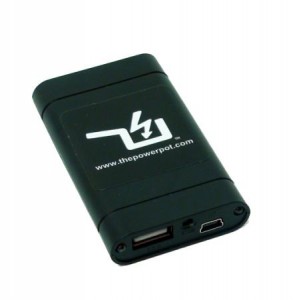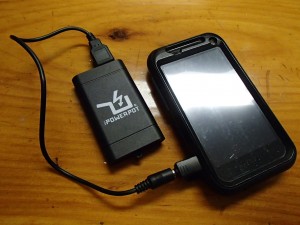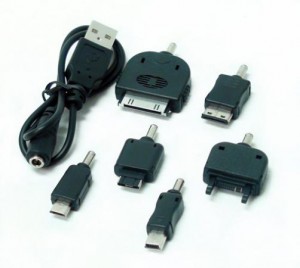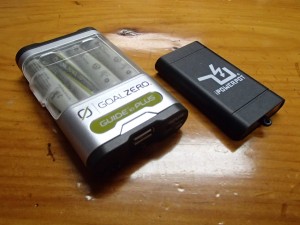Overview:
“The rechargeable 1800 mAh lithium ion battery with USB port is perfect for charging your cell phone or MP3 player on the go.” – Power Practical
The Deets:
Charge Time: 3-4 hours (at 2.5W)
Capacity: 1800mAh
Inputs: Mini-USB port (2.5W, 0.5A max)
Outputs: Standard USB port (2.5W, 0.5A max)
Physical Size: 1.75 x 3 x 0.5 in
Weight: 0.2 lbs
MSRP: $25.00
The Review:
The Power Practical Lithium 1800 Battery Pack is a lightweight power-pack capable of recharging your small electronics (cell phones, smart phones, GPS, VHF radios, ect) while in the field via a standard USB. The internal lithium battery can be recharged by a number of devices including the Power Practical PowerPot, computer, vehicle accessory port; basically anything with a standard USB port! Once charged, this battery pack is capable of outputting up to 2.5W (0.5Amax on standard 5V USB port) to charge your small electronics. The battery pack comes with a 12in long USB cable with multiple adapters for Samsung, Nokia, Blackberry, iPod, mini-USB, and micro-USB compatible devices. The built-in LED flashlight adds to the utility of the pack for backcountry and emergency preparedness applications.
I’ve had a chance to run the Lithium 1800 battery pack through its paces a few times and overall I was satisfied with its performance. It took about 3.5-4 hours to fully charge the battery pack via a computer USB port. This port provided a steady source of power at the maximum recharge rate of 2.5W as verified by a USB power meter. This 2.5W maximum recharge rate may seem to be a disadvantage at first glance especially when you consider that similar battery packs such as the GOAL Zero Guide 10 Plus are capable of recharging at 5W. However, it’s important to consider that most backcountry charging devices (such as solar panels) are not capable of reliably outputting at a 5Wmax recharge rate while rates between 2-3W are more realistic.
This battery pack also proved to have an acceptable discharge rate. A fully-charged pack provided a 75% charge to my HTC Droid Incredible 2 smartphone in a little less than 1.5 hours. I thought that this was pretty good for an 1800mAh battery pack! For example, the GOAL Zero Guide 10 Plus (a 2000mAh battery pack) provides one full charge to the same smart phone in about 2 hours. Also, the fact that the battery pack came with multiple charging adapters turned out to be quite handy as I was able to bring along only one USB cable (included) and a few small adapter tips to keep my smartphone and headlamp charged. This is much better than carrying multiple cords to cover your selection of rechargeable devices!
The million dollar question is always how one battery pack compares to another. Let’s take the Goal Zero Guide 10 Plus battery pack as the standard to compare to. In terms of physical size and weight, the Power Practical Lithium 1800 is half as big as the Guide 10 Plus. However it only provides about half as much power. Therefore, it’s not unreasonable to consider that two Power Practical Lithium 1800 packs would be equal to one Goal Zero Guide 10 Plus pack in terms of physical size and power output (i.e. they are substantially equivalent). This is also true in terms of price point with the Lithium 1800 pack ($25.00MSRP) being about half as expensive as the Guide 10 Plus pack ($40.00MSRP). One major downside is that the internal battery limits its versatility when compared to packs that recharge AA or AAA batteries. The nice thing about the Lithium 1800 pack is that its small footprint and weight make is a better choice for a quick trip in which you would like to have a backup battery to charge your phone but don’t see the need to carry along a larger battery pack.
Overall, I was quite satisfied with the performance of the Power Practical Lithium 1800 battery pack! At first glance, the pack seems to be half the size and half as powerful as other popular backcountry battery packs. However, when you normalize its specs (weight, power, and cost) against the competition you will find that it is substantially equivalent in terms of performance. The real benefit of the Lithium 1800 battery pack is that its small footprint and low price point make it an excellent choice to serve as a backup battery on a quick trip!
-Kayak Dave
Pros: Small footprint, Lightweight, Reasonable charge and discharge times. Includes flashlight.
Cons: Internal battery limits versatility (other packs allow you to charge AA or AAA batteries that can be used in your electronic devices).
BETA: Be sure to test the compatibility of the Guide 10 Plus with all of your small electronics prior to your trip and be sure to bring along the USB cable and appropriate charging tips (included). Also, I recommend charging this battery before you venture off so that it is ready to go in a pinch!
Kayak Dave Rating:







